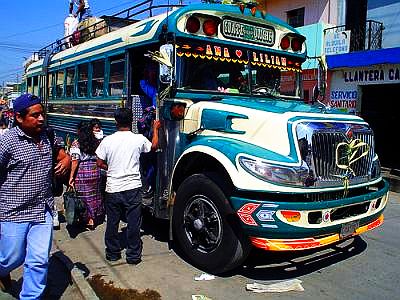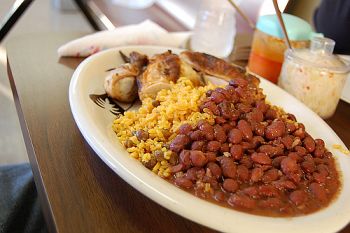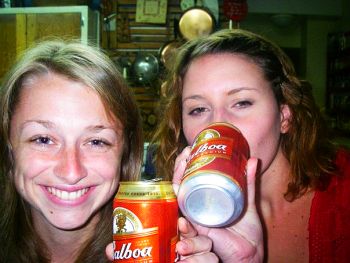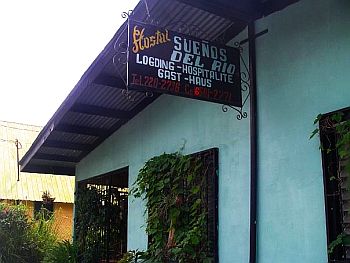Last year, when my friend Lindsey and I started cooking up a plan for a month-long trip somewhere, we had a few requirements to work around. We wanted to go some place that would offer cultural opportunities, adventure and beautiful scenery—but we also knew we had a really tight budget to work with. Recently graduated and not much money in our bank accounts, we almost immediately decided that Central America was the place to go. Since airfare to Central America tends to be relatively inexpensive from the United States and most of the countries are a budget travelers dream, we booked our tickets to Panama and began to plan our Central American adventure.
While some of the coastal resort areas of Mexico, Belize and Costa Rica cater to tourists on short, all-inclusive type vacations (and are priced to match), there are plenty of other options for those traveling on a tighter budget. In many ways, Nicaragua, Honduras, El Salvador, Guatemala and Panama all offer some of the world’s best travel bargains.
Getting to Central America for Cheap
For travelers coming from the United States and Mexico, it will usually only cost you $100-$200 more to fly into many of the Central American cities than a domestic flight. Depending on the time of year, city of origin and destination, you can usually count on being about to get airfare for anywhere from $400-$700 without too much difficulty.
While you may not plan on spending any time in the capital cities of Central America (which I would recommend you didn’t), flying directly into these cities and busing it to your final destination is sure to save you hundreds of dollars on airfare. Check here for great deals on cheap international airfare.
Budget Planning: Where to go
 If you are trying to stick to a tight budget ($20-$25 a day) you are best off skipping certain areas altogether. Forget heading to the coastal Mexican resort towns (Cancun, Puerto Vallarta, Mazatlan, Cabo San Lucas) as well as the islands of Belize as well as many of the main tourist towns along the Pacific coast of Costa Rica.
If you are trying to stick to a tight budget ($20-$25 a day) you are best off skipping certain areas altogether. Forget heading to the coastal Mexican resort towns (Cancun, Puerto Vallarta, Mazatlan, Cabo San Lucas) as well as the islands of Belize as well as many of the main tourist towns along the Pacific coast of Costa Rica.
When Lindsey and I chose Panama, we did so precisely because we knew we could probably stay longer and do more for less money than if we traveled in neighboring Costa Rica. While there are definitely still ways to see and explore these areas on a budget, you’ll find that Mexico, Belize and Costa Rica tend to be on the high-end price wise and Nicaragua, Guatemala and Honduras on the lowest end.
Keep in mind that almost any time you find yourself in a popular tourist spot or in an already discovered beautiful beach town, you are likely to see a jump in prices that reflects the influx of travelers and outsiders coming to the region. While things may still be priced reasonably, you will almost always find the lowest prices in smaller, isolated and less exposed regions unaccustomed to seeing many tourists.
For those who can speak Spanish, you also tend to fare a little better in being able to get a fairer price and being able to negotiate with locals.
Another tip is to find good budget alternatives to certain destinations. For example, while Rotan Island in Honduras continues to get more expensive every year, nearby and equally beautiful Utila offers a good budget alternative. Backpacker destinations and places not yet discovered by big hotels, resorts and other travelers will always offer better bargains.
Getting Around on a tight budget
 While internal flight prices do tend to be fairly reasonable, they are seldom a great bargain and a sure fire way to blow through your budget quickly.
While internal flight prices do tend to be fairly reasonable, they are seldom a great bargain and a sure fire way to blow through your budget quickly.
Luckily for those travelers trying to get around without spending much, almost all of Central America is well connected by buses, most of which don’t cost more than a few dollars even to cover longer distances.
While these buses are not always the most luxurious or comfortable ride (yes, sometimes you will be sharing the bus with chickens, large bags of produce and more people you thought possible to fit into a small space), they provide relatively reliable transportation to and from almost anywhere in the various Central American countries.
Taking the buses is also generally a safe way to travel. While you still should exercise caution (and keep your valuables hidden or securely on you), traveling around Central America via public transportation is definitely not only a cheap way to get around, but also a safe one.
Keep in mind that bus travel is not always a time efficient way to go—as some local buses can take several hours to cover a relatively small distance. Keep this in mind before venturing out on a day trip or when planning how far to travel in one day. However, for the cost of just a few American dollars you can easily cover large distances with relative ease.
>>Read more about Bus Travel in Central America
Taxis are also usually inexpensive in Central America, except once again in major tourist zones in Costa Rica, Belize, and Mexican beach resorts. You can also often hire a car and a driver for a day for the same amount or less than renting a car.
If you are trying to keep you budget under $30/day, regional flights and renting a car are out of the question. If time is more valuable than money on your vacation, this is probably a better way to go, but it is also sure to blow your tight budget really quickly.
Eating Cheaply in Central America
 Because eating is such a huge part of any travel experience for me, knowing that I would be eating well and still not spending much money was a huge bonus to traveling in Central America. In most countries and in most places, it is easy to get a full meal that costs anywhere from $2-$6. While Central America is a vast region and it is hard to make many generalizations about travel there, when it comes to meals it is pretty easy to get a decent meal for cheap anywhere from Cancun to Panama City.
Because eating is such a huge part of any travel experience for me, knowing that I would be eating well and still not spending much money was a huge bonus to traveling in Central America. In most countries and in most places, it is easy to get a full meal that costs anywhere from $2-$6. While Central America is a vast region and it is hard to make many generalizations about travel there, when it comes to meals it is pretty easy to get a decent meal for cheap anywhere from Cancun to Panama City.
If you are looking to keep your food budget to a minimum and want to eat like a local, avoid restaurants that cater to tourists. English on the menu usually means higher prices to reflect the clientele. Look for where the locals eat.
You will find many simple restaurants, market stalls and cafeteria style restaurants where you can get a simple and filling meal—usually which consists of ingredients like rice, beans, tortillas, eggs, fired plantains and meat (usually chicken) . On the coasts you will find more seafood and fish dishes.
Don’t be afraid to eat like the locals. One of my best meals in Panama consisted of roasted chicken and fried yucca served from an open air shack in Santa Catalina, all for about $3. If you are trying to stick to a tight budget and want to stay well nourished, avoiding the restaurants where the tourists dine and opting for simple and nourishing food is the best way to keep your eating costs way down.
To my delight, I also found that some items that are expensive at home were abundant and cheap in Central America. Pineapple, avocados, mangos and a variety of other tropical fruits can be bought at produce stands almost anywhere and usually don’t cost a whole lot. The fresh tropical fruit makes for a delicious, satisfying, healthy and cheap snack while on the road.
Drinking Cheap in Central America
 If your travel plans in Central America also include indulging in the local drink, you’ll be happy to know that you can still enjoy nights out partying without ending up with a giant bar tab. Rum, tequila, and usually some sort of sugar cane derived alcohol tend to be the drinks of choice throughout Central America.
If your travel plans in Central America also include indulging in the local drink, you’ll be happy to know that you can still enjoy nights out partying without ending up with a giant bar tab. Rum, tequila, and usually some sort of sugar cane derived alcohol tend to be the drinks of choice throughout Central America.
The cheapest way to drink in Central America is probably to buy a bottle of booze from a local cantina, and get a couple of bottles of Coke. That way, you have a ton of drinks for several people for under $15. You will also find a clear liquor distilled from sugar cane in many Central American countries. Called Guaro in Costa Rica and Seco in Panama, while this type of booze may be nearly akin to rubbing alcohol, it is almost always dirt cheap.
Beer is also usually quiet affordable in Central America and can range in cost from .50 to about $2 depending on where you find yourself. Again, tourist bars and destinations will mean higher drink prices.
Most Central American countries have a few different national brands that are popular and the beer is usually a lager style cerveza that can range from great to just passable.
Keep in mind that save for resort towns popular with backpackers and young people and some of the larger, more progressive cities, bars tend to be a male affair in Central America. In a region where machismo still very much rules, females should scope out a bar before heading in, especially if traveling with another woman or by herself.
Cheap Accommodation in Central America
 Budget accommodations are plentiful throughout Central America and most will be amazed by what kind of room they can get for not a whole lot of money. While you’ll probably want to search out dormitory style hostels in more expensive tourist zones, there are plenty of places where you can get a private room with a shared or private bath for as little as $4-$8/per night.
Budget accommodations are plentiful throughout Central America and most will be amazed by what kind of room they can get for not a whole lot of money. While you’ll probably want to search out dormitory style hostels in more expensive tourist zones, there are plenty of places where you can get a private room with a shared or private bath for as little as $4-$8/per night.
While accommodations will be more expensive in Costa Rica, Mexico and Belize, even in these countries it’s usually possible to find rustic, dorm style accommodations for as little as $2-$10/night.
When traveling in Panama, my travel partner and I never had a problem finding decent and comfortable accommodations in private rooms for under $10, even in some of the more tourist traveled areas like Bocas del Toro. If you feel like you could use a night with a little more pampering, spending another $5 to $10 a night is usually enough to get you a hotel with a private bath, maid service and perhaps even a hotel with a patio, courtyard or garden.
With simple accommodations starting as low as $2 a night in some places, finding a cheap place to stay should not be a problem in most places in Central America—making it easy to stay on budget.
Other Tips for saving money and staying on budget
- Slow Down— No matter where in Central America you find yourself, the best and easiest way to save money and keep your budget low is to simply slow down. Not moving around too quickly (and therefore saving on transportation costs) is a great way to stretch your dollars.
- Pop and juice is cheaper than water—Since the water is not safe to drink in much of Central America, you will be forced to spend some of your budget on bottled water. However, you will also find many areas with juice stands (with fresh squeezed tropical juice) and pop (made with sugar instead of corn syrup). These options are almost always cheaper than water. While I don’t suggest you replace water drinking with juice and pop, subbing in these beverage items can be a good way to keep a little extra dough in your pocket.
- Pick guided activities and tours wisely—Especially in areas with a higher concentration of tourists, you are sure to find plenty of opportunities for taking guided canopy tours, river rafting excursions and more. Pick and choose these types of adventures wisely. While you certainly don’t want to miss out on something great because it costs $10-$25, you also don’t want to be spending all your cash on tours and activities that may not provide you with all that cool of an experience—and will cut into your budget big time.
- Don’t be afraid to make little splurges—If you are trying to stick to a tight budget, but are traveling for a longer period of time and feel like you need a break from the rice and beans or dorm style accommodations, don’t be afraid to splurge a little more one day. Just remember you’ll probably have to cut back the next to make up for it. Making small splurges can also be a good way for you to stay sane and keep traveling cheap.
- Write down what you spend–I always like to keep a little pad of paper or notebook on me with traveling, and keeping a page where you write down your expenses (how much you spent on what) is a great way to keep your budget on your mind, see where and how you are spending your money and see if there are areas where you can cut back.

Read more about South America:
- How to Get Around Visa Fees in South America
- 10 Places in South America to Escape the Northern Winter
- Wine Tasting in South America: Where to Go and What to Try
- Experiences Not to Miss in Bolivia
- Traditional Markets in Latin America: A Guide for First Time Shoppers
- The Incredible National Parks of South America
About the Author
Although BootsnAll staff writer Julie Blakley spends most of her time writing about traveling in France for the Paris Travel Guide and France Travel Guide, she left her heart in Central America after a month long backpacking trip around Panama. From steamy jungles to gorgeous beaches and heaping piles of rice, beans and yucca frita, there isn’t a whole lot Julie doesn’t love about Central American adventures.
photos: Guatemalan currency by Antigua Daily Photo on flickr , rice, beans and chicken plate by stu_spivack on flickr, all other photos by Julie Blakley.